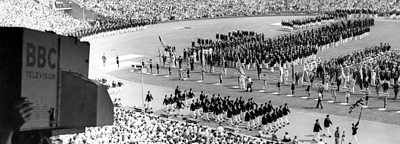Coverage of the XIVth Olympiad in 1948 was one of the great successes of the postwar Television Service. It nevertheless posed the ���˿���, as the ���˿��� Yearbook subsequently noted:
a planning and operational problem which had never before been encountered in the history of any broadcasting organization in the world.
Television had previous experience of covering major national events such as the 1946 Victory Parade and the marriage of Princess Elizabeth and Philip Mountbatten, Duke of Edinburgh, in 1947, but nothing compared to the ambition and scale of the Olympic operation.
The complexity of multi-event broadcasting, as we can recognise from our own experience of watching recent Olympic Games, presented the ���˿��� of 1948 with unique challenges in terms of the breadth of coverage. As Tony Bridgewater, the engineer in charge, recalled for the ���˿��� Oral History Collection, it also tested the technical limits of live television broadcasting.
As can be seen from this ���˿��� film about the televising of the Olympics, the Games were a proving ground for new and more advanced equipment. It also rapidly expanded the capacity of the ���˿��� to do large-scale outside broadcasts as well as advancing the craft of making television.
The unprecedented scale of covering the Olympics required a full year of planning and preparation. When up and running, operations were directed from the Broadcasting Centre next to Wembley Stadium – previously the Palace of the Arts building during the 1924 British Empire Exhibition.
From here, thirty two separate broadcasting channels were set up to orchestrate Olympic coverage not just for domestic television viewers and radio listeners, but for a global audience eager to hear the latest news around the clock.
As with the coverage of other major events, such as the 1953 Coronation, the Olympics demonstrated the extent to which Outside Broadcasts – or "OB's" as they were often referred to – were an integral part of the success of the postwar Television Service.
In his Oral History interview for the ���˿���, Peter Dimmock, one of the most influential OB producers and directors of the period explained some of the challenges of bringing the service back to life after the war. He also described the evolving nature of a genre that, alongside the coverage of sporting and state occasions, tried to creatively engage viewers with a world beyond their immediate experience.
Aubrey Singer, a former Controller of ���˿��� 2 and then Managing Director of Television, argued that what made OB’s so compelling "was the live nature of the medium". This "liveness" imparted a sense of immediacy, allowing viewers to become participant observers in the events they watched. It was this co-existence between the experience of watching television and the uncertainty of live events as they were unfolding that made Outside Broadcasting, Singer continued, "the central part of the Television Service".
The ���˿��� and the 1948 Olympic Games
-

The Birth of TV: London 1948 Olympics
The '100 Voices that Made the ���˿���' project unearth unique oral histories from the team who made the biggest outside broadcast ever attempted. -

Broadcasting the 1948 Games
How the coverage looked, sounded and how it was promoted by the ���˿��� in 1948. -

Staging the 1948 Olympic Games
Senior television engineer Norman Green recalls the preparation for the biggest outside broadcast yet attempted -

Working on the London 1948 Olympic Games
Producers, camera operators, and others recall how they coped with a tiny budget and pre-war equipment.

